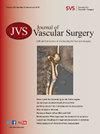球囊和自膨胀支架治疗股总动脉狭窄的评估。
IF 3.9
2区 医学
Q1 PERIPHERAL VASCULAR DISEASE
引用次数: 0
摘要
背景:目前,股总动脉及其分叉处的血管内治疗建议用于腹股沟有敌意(曾接受股骨分叉处开放手术、放疗史)(5) 或严重合并症(高龄、虚弱、肥胖)的患者。初步结果显示疗效良好(7)。在不同的血管内技术(动脉粥样硬化切除术、血管内碎石术(IVL)、普通球囊血管成形术、药物涂层球囊血管成形术、支架置入术)中,支架是主要的应用手段,但使用哪种支架最好仍存在争议。本研究旨在评估球囊扩张支架(BES)和自扩张支架(SES)对股动脉分叉狭窄的价值:纳入2016年至2022年期间连续收治的CFA及其分叉狭窄患者。收集了人口统计学数据、使用的支架类型、手术数据和血管造影变量。根据植入支架的类型定义分组。主要通畅率被定义为二元终点,即在没有临床驱动的靶病变血管再通或靶病变搭桥的情况下,双相超声评估的收缩速度峰值比为2.4或更低。次要结果是临床持续改善、12 个月内无靶病变血管再通(TLR)、平均 ABI 改善、主要辅助通畅率和次要通畅率:共有 77 名患者接受了 90 例手术,其中 SES 组 26 例,BES 组 64 例。根据卢瑟福分类法,最常见的症状为2级、3级和4级(分别占28%、48%和8%)。根据 AZEMA 分类法评估的 CFA 病变类型在两组之间具有可比性(SES/BES 组 2 类:31%/27%;3 类:54%/62%)。12 个月时,SES 和 BES 的主要通畅率分别为 88%(26/26 例患者)和 72%(58/64 例患者)(P=0.10)。12个月后,SES和BES的无靶病变血运重建率(TLR)分别为97%和81%(P=0.13):结论:自扩支架治疗 CFA 狭窄显示出更好的通畅性趋势,12 个月后的无 TLR 率也更高。然而,要进一步研究这一趋势的意义,还需要进行对照研究。本文章由计算机程序翻译,如有差异,请以英文原文为准。
Evaluation of balloon and self-expandable stents for common femoral artery stenosis
Background
Endovascular treatment of the common femoral artery (CFA) and its bifurcation is currently recommended for patients with hostile groin (prior femoral bifurcation open surgery, history of radiotherapy) or severe comorbidities (advanced age, frailty, obesity). Preliminary results have shown favorable outcomes. Among the different endovascular techniques (atherectomy, intravascular lithotripsy, plain balloon angioplasty, drug-coated balloon angioplasty, stenting), stents are mainly used but the best type of stent to use is still debated. The aim of this study was to assess the value of balloon-expandable stents (BES) and self-expandable stents (SES) for stenosis of the femoral bifurcation.
Methods
Consecutive patients with stenosis of the CFA and its bifurcation were included from 2016 to 2022. Demographic data, the type of stent used, procedural data, and angiographic variables were collected. Groups were defined according to the type of stent implanted. Primary patency was defined as a binary end point based on a duplex ultrasound peak systolic velocity ratio of ≤2.4 as assessed by duplex ultrasound examination, in the absence of clinically driven target lesion revascularization (TLR) or bypass of the target lesion. Secondary outcomes were clinical sustained improvement, freedom from TLR at 12 months, mean ankle-brachial index improvement, primary-assisted patency, and secondary patency.
Results
A total of 90 procedures conducted in 77 patients were included in this study, 26 in the SES group and 64 in the BES group. The most common symptomatology according to the Rutherford classification was class 2, 3, and 4 (28%, 48%, and 8%, respectively). The type of lesions in the CFA, assessed using the Azema classification, were comparable between both groups (SES/BES group type 2: 31%/27%; type 3: 54%/62%). At 12 months, the primary patency rates for SES and BES were 88% (26/26 patients) and 72% (58/64 patients) (P = .10). At 12 months, freedom from TLR rates for SES and BES were 97% vs 81%, respectively (P = .13).
Conclusions
SES for CFA stenosis show a trend toward better patency and freedom from TLR rates at 12 months. However, controlled studies are warranted to further investigate the significance of this trend.
求助全文
通过发布文献求助,成功后即可免费获取论文全文。
去求助
来源期刊
CiteScore
7.70
自引率
18.60%
发文量
1469
审稿时长
54 days
期刊介绍:
Journal of Vascular Surgery ® aims to be the premier international journal of medical, endovascular and surgical care of vascular diseases. It is dedicated to the science and art of vascular surgery and aims to improve the management of patients with vascular diseases by publishing relevant papers that report important medical advances, test new hypotheses, and address current controversies. To acheive this goal, the Journal will publish original clinical and laboratory studies, and reports and papers that comment on the social, economic, ethical, legal, and political factors, which relate to these aims. As the official publication of The Society for Vascular Surgery, the Journal will publish, after peer review, selected papers presented at the annual meeting of this organization and affiliated vascular societies, as well as original articles from members and non-members.

 求助内容:
求助内容: 应助结果提醒方式:
应助结果提醒方式:


